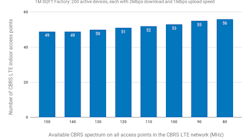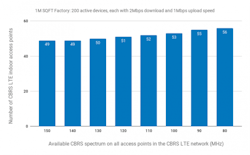Private mobile networks as a foundation for smart industry
Celona's Dr. Mehmet Yavuz
By Dr. Mehmet Yavuz, CTO and co-founder, Celona
One critical missing piece in the digital-transformation discussion has traditionally been a wireless network that delivers on the deterministic performance required by such digital initiatives.
What's required to support this new era of IoT systems is a new class of wireless networks not impacted by constant business processes and environmental changes within a warehouse environment…a mobile network infrastructure that is not affected by client access, roaming and interference issues. Because IoT systems have become vital to business operations, modern wireless networks must guarantee low latency for voice and predictable throughput for video. They must also have the ability to extend wireless coverage without incurring massive capital costs from having to deploy tens or hundreds of additional access points.
These guarantees are precisely the value behind new private mobile networks (PMNs). Like the public cellular network that most of us use for our smartphones and tablets, PMNs are built with enterprise IT in mind, using technologies like LTE and 5G as the wireless protocols for client connectivity. The big difference is that PMNs are not owned and operated by wireless service providers like Verizon or AT&T. PMNs are owned and operated by a single organization, much like existing wireless LANs that use the 802.11 protocol.
In the US, these networks leverage the new unlicensed CBRS spectrum band that operates between 3.55-3.7Ghz. This allows manufacturers to easily deploy their own LTE or 5G private mobile cellular network, managed similarly to how they manage their WiFi network today.
This gives industrial organizations a compelling new option for predictable wireless connectivity, performance and mobility, serving a variety of applications that can't tolerate the operational nuances of today's wireless systems. Use cases include mission-critical infrastructure on the factory floor, process automation using AGVs, inventory management via rugged tablets that can also be vehicle-mounted, voice communications with push-to-talk handsets, and much more.
PMNs based on the CBRS spectrum operate within a dedicated and relatively interference-free cellular spectrum band as defined by recent FCC regulations in the US and other telecommunications regulatory bodies worldwide. This allows manufacturers to significantly reduce the ongoing operational expenses and support costs historically experienced by companies having to constantly troubleshoot client access and wireless connectivity problems.
Private mobile networks are based on cellular technology that provides centralized network coordination of user access to eliminate media contention from clients fighting for access. This coordination makes PMNs ideal for applications and IIoT devices that require uninterrupted performance and ultra-reliable connectivity to perform their core functions.
Beyond reliability, CBRS-based networks have been developed to deliver low-latency connections that minimize delay, jitter and packet loss that can ruin application performance and business productivity.
Unlike other wireless alternatives, PMNs can provide specific performance guarantees at an established Quality of Service (QoS) across the entire radio access and local area networks. Today's 4G/LTE private mobile networks are delivering enterprises sub-20 millisecond latency. And with the introduction of 5G, this latency is expected to drop even further. Such low-latency wireless connections have become a critical and non-negotiable requirement for factory-automation tasks and most IIoT applications.
Another significant benefit of this new spectrum-based "traffic lane" is that it ensures the manufacturing-data traffic is kept local; it remains secure and separate from networks used by guests or other personnel. With PMNs, security, encryption and device authentication are no longer a manual process for IT staff. This built-in security is a critical element for business and safety reasons.
Outdoors, CBRS-based private mobile networks are also ideal for connectivity across settings such as transportation yards, outdoor warehouse locations, or manufacturing-site parking lots. With the ability to cover one million square feet of outdoor space using a single outdoor wireless access point, a PMN significantly reduces the amount of outdoor cabling, switch ports, and power required to support a wireless network infrastructure, thereby reducing a good chunk of any organization’s IT capital expenses.
One of the most significant issues is figuring out the total number of indoor and outdoor CBRS LTE access points (AP) you might need at your facility, given size, geo-location, density, and performance requirements.
Let's look at one scenario for an indoor factory and what would be required to establish total network coverage and then design that network to provide maximum capacity. Consider an indoor facility of about one million square feet. There is a reasonable chance most facilities this size will have around 2500 devices concurrently active. In this scenario, a CBRS-based PMN would require around 43 APs to ensure highly reliable coverage across the entire facility. If designing for capacity, we've included a chart below that details what kind of infrastructure would be needed, assuming a download capacity of 3 Mbps and an uploaded capacity of 1 Mbps.
The design scenarios for manufacturers to implement private mobile networks are already well-defined. Useful planning tools are valuable to determine the number of access points needed and the expected throughput.
Whether your IT/OT department is interested in building its own network or implementing a PMN as a managed service, the benefits are clear with myriad options to consider. As 5G continues to proliferate, PMNs will continue to establish themselves as the connective fabric enabling the digital transformation of industrial firms everywhere.





